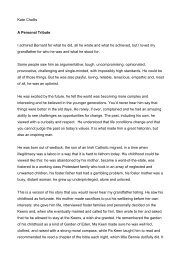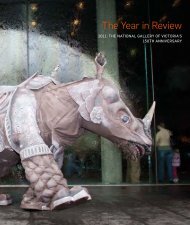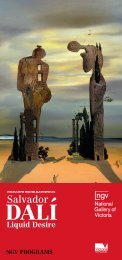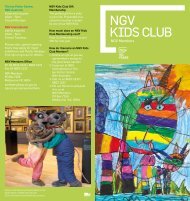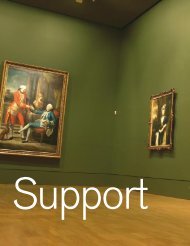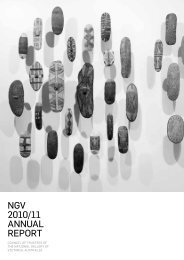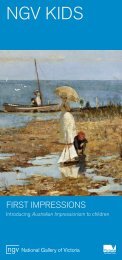Shared Sky Education Guide - National Gallery of Victoria
Shared Sky Education Guide - National Gallery of Victoria
Shared Sky Education Guide - National Gallery of Victoria
You also want an ePaper? Increase the reach of your titles
YUMPU automatically turns print PDFs into web optimized ePapers that Google loves.
<strong>Shared</strong> <strong>Sky</strong><br />
<strong>Education</strong> Resource<br />
In 2009 the world celebrates the International Year <strong>of</strong><br />
Astronomy. This year marks the 400 year anniversary<br />
<strong>of</strong> Galileo’s first observations <strong>of</strong> the universe through a<br />
telescope, as well as forty years since Neil Armstrong first<br />
stepped on the moon.<br />
This education resource <strong>of</strong>fers<br />
many curriculum links to mark these<br />
astronomical events. It provides<br />
opportunities to discuss significant<br />
developments in astronomy and<br />
explores the southern sky from<br />
different cultural perspectives, which<br />
reflect the complexities <strong>of</strong> Australia’s<br />
histories.<br />
The information and discussion<br />
points are suitable to use with middle<br />
years students (VELS levels 4–6) and<br />
for a range <strong>of</strong> learning areas across<br />
the curriculum, including the Arts,<br />
Science, History and English.<br />
The discussion points may be<br />
used before, after or during your<br />
visit to the <strong>Shared</strong> <strong>Sky</strong> Exhibition<br />
(13 Mar – 2 Aug, 2009) at NGV<br />
Australia. It is suggested that<br />
teachers select relevant sections<br />
<strong>of</strong> the resource to suit their own<br />
curriculum requirements and the<br />
needs <strong>of</strong> their students.<br />
The catalogue for <strong>Shared</strong> <strong>Sky</strong><br />
is available for purchase from<br />
the NGV Bookshop or online<br />
at the NGV Shop.<br />
For details on a range <strong>of</strong> School<br />
Programs, telephone (03) 8620 2340<br />
(weekdays) or email education.<br />
schoolprograms@ngv.vic.gov.au.
<strong>Shared</strong> <strong>Sky</strong> <strong>Education</strong> Resource<br />
<strong>Shared</strong> stories<br />
<strong>of</strong> the Southern Cross<br />
For thousands <strong>of</strong> years, people<br />
from cultures around the globe<br />
have questioned existence and<br />
humanity’s relationship with<br />
the Earth, Sun, Moon and stars.<br />
Through the prisms <strong>of</strong> science,<br />
religion and cultural lore, the night sky<br />
continues to <strong>of</strong>fer a site for universal<br />
projections <strong>of</strong> ancient beliefs,<br />
nationhood and personal reflection.<br />
Why do you think scientists<br />
believe that understanding the<br />
universe helps us to understand<br />
ourselves and our world?<br />
What is the difference between<br />
astronomy and astrology?<br />
Create a timeline <strong>of</strong> the history<br />
<strong>of</strong> astronomy.<br />
Aboriginal and Torres Strait Islander<br />
peoples have observed the night<br />
sky for more than 40,000 years.<br />
Their knowledge <strong>of</strong> particular star<br />
clusters and constellations has been<br />
used for many purposes, including<br />
navigation, time keeping and as a<br />
means <strong>of</strong> telling Ancestral narratives<br />
for teaching and learning about<br />
cultural practices. The movement <strong>of</strong><br />
stars across the sky has also been<br />
used as a calendar to mark the<br />
changing seasons and to indicate<br />
the availability <strong>of</strong> food. The stories<br />
associated with these star clusters<br />
and constellations ascribe specific<br />
meanings to the sky <strong>of</strong> the southern<br />
hemisphere. Many Aboriginal<br />
language groups hold their own<br />
beliefs and interpretations <strong>of</strong> star<br />
clusters observed in the night sky<br />
above their lands. Similarities are<br />
found in the interpretations <strong>of</strong> the<br />
Milky Way, the constellation <strong>of</strong> Orion,<br />
Pleiades and the Clouds <strong>of</strong> Magellan.<br />
However, there is wide variation in<br />
the stories concerning the Southern<br />
Cross.<br />
What are the Clouds <strong>of</strong><br />
Magellan?<br />
Look at works <strong>of</strong> art by several<br />
Indigenous and non-Indigenous<br />
artists and compare their<br />
depictions and stories <strong>of</strong> the<br />
Milky Way, Orion and other<br />
constellations.<br />
The Southern Cross is the best<br />
known star group in the southern<br />
hemisphere. In Melbourne, it can be<br />
seen all year round. It is the smallest<br />
<strong>of</strong> the eighty-eight constellations, but<br />
it is made up <strong>of</strong> some <strong>of</strong> the brightest<br />
stars. It is composed <strong>of</strong> four main<br />
stars, Acrux (Alpha), Mimosa (Beta),<br />
Gacrux (Gamma) and Delta. These<br />
stars depict the extremities <strong>of</strong> a Latin<br />
cross, although it is also considered<br />
to be a kite shape. There is a fifth<br />
star, Epsilon, which interferes with<br />
the regularity <strong>of</strong> the cross. Alpha and<br />
Beta Centauri, respectively the third<br />
and tenth brightest stars in the sky,<br />
act as pointers that guide the way to<br />
the top <strong>of</strong> the cross.<br />
In hot Australian deserts,<br />
it is <strong>of</strong>ten better to walk<br />
longer distances through<br />
the night than during the<br />
day. Investigate how the<br />
Southern Cross can be used<br />
to find the South Celestial<br />
Pole and as a time-telling<br />
device.
<strong>Shared</strong> <strong>Sky</strong> <strong>Education</strong> Resource<br />
The stars <strong>of</strong> the Southern Cross<br />
were known to the ancients and<br />
visible to equatorial cultures.<br />
In the second century, Greek<br />
astronomer Claudius Ptolemy<br />
grouped these stars into the rear legs<br />
<strong>of</strong> the constellation <strong>of</strong> Centaurus.<br />
They were sighted in 1515 by Andrea<br />
Corsali while on board a Portuguese<br />
ship heading for the Indian Ocean<br />
and illustrated by Mollineaux <strong>of</strong><br />
England in 1592. The stars <strong>of</strong> the<br />
Southern Cross were separated<br />
from Centaurus to become an<br />
independent constellation in 1679<br />
when the French architect and<br />
cartographer Augustin Royer <strong>of</strong>ficially<br />
named them Crux.<br />
Who was Claudius Ptolemy,<br />
and what were his major<br />
contributions to astronomy?<br />
Use a planisphere to determine<br />
the path <strong>of</strong> the constellation<br />
<strong>of</strong> Centaurus as it travels<br />
across the sky in the southern<br />
hemisphere.<br />
There are no Greek or Roman<br />
legends associated with the Southern<br />
Cross, however, many Indigenous<br />
stories relate to this group <strong>of</strong> stars<br />
and the dark nebula beside it, known<br />
as the Coalsack. On Groote Eylandt,<br />
an island situated in the Gulf <strong>of</strong><br />
Carpentaria in the Northern Territory,<br />
the stars <strong>of</strong> the Southern Cross are<br />
known as two fishermen and their<br />
cooking fires. To the Ngarrindjeri<br />
people <strong>of</strong> South Australia, the dark<br />
shape <strong>of</strong> the cross is the stingray,<br />
Nunamara, and the pointers are the<br />
sharks, Ngarakani, which chase<br />
the stingray across the sky. The<br />
Boorong people <strong>of</strong> north-west<br />
<strong>Victoria</strong> see Bunya, the ringtail<br />
possum, as he hides in a tree after<br />
running from Tchingal, the evil emu<br />
who terrorised people. The silhouette<br />
<strong>of</strong> Tchingal is seen in the shadowy<br />
expanse <strong>of</strong> the Coalsack, next to<br />
the Southern Cross. For the Kulin<br />
people, a federation <strong>of</strong> five distinct<br />
but strongly related communities<br />
around Melbourne, the Southern<br />
Cross represents Bundjil, who takes<br />
the form <strong>of</strong> an eagle, the creator <strong>of</strong><br />
people, land, law and language.<br />
Mankokkarrng (The Southern<br />
Cross), 1948, is a work on paper<br />
by an unknown artist from Oenpelli<br />
in Arnhem Land and depicts<br />
the constellation in a kite-like<br />
configuration. The four large stars<br />
are the eyes <strong>of</strong> the Nangurgal, a<br />
group <strong>of</strong> Star men from the Ancestral<br />
period. The Nangurgal went hunting<br />
with their sons, who are represented<br />
by the smaller stars, and caught a<br />
large, non-venomous snake. After<br />
they cooked it and ate their meal, the<br />
Nangurgal’s eyes glowed so brightly<br />
they could be seen by people on<br />
Earth. The crescent shape <strong>of</strong> the<br />
snake represents the Milky Way and<br />
an adjacent star is the gunark, or fire,<br />
on which the snake was cooked.<br />
Unknown<br />
active in Australia (1940s)<br />
Mankokkarrng (The Southern Cross) 1948<br />
earth pigments on paper on cardboard<br />
<strong>National</strong> <strong>Gallery</strong> <strong>of</strong> <strong>Victoria</strong>, Melbourne<br />
Presented by the Commonwealth Government,<br />
1956
<strong>Shared</strong> <strong>Sky</strong> <strong>Education</strong> Resource<br />
The Southern Cross has been<br />
incorporated into the flags <strong>of</strong><br />
several nations situated in the<br />
South Pacific. On the Australian<br />
flag, the stars reflect the nation’s<br />
geographical location and a<br />
government based on freedom and<br />
democracy. For many, these stars are<br />
a familiar and comforting sight, but<br />
for those new to this land they can<br />
be foreign and unnerving. Ludwig<br />
Hirschfeld Mack was born in 1893 in<br />
Frankfurt. He fled from Germany to<br />
England in 1936 to escape the rise <strong>of</strong><br />
Nazism. In 1940, he was deported to<br />
Australia as an ‘enemy alien’ and<br />
spent two years in internment camps<br />
in New South Wales and <strong>Victoria</strong>, at<br />
Hay, Orange and Tatura. During this<br />
time, he made a number <strong>of</strong> woodcuts<br />
that illustrated his life in detention.<br />
When creating these works he used<br />
the same printing techniques, which<br />
he taught art students at the Weimar<br />
Bauhaus. One <strong>of</strong> his most poignant<br />
images is the solitary, unidentified<br />
figure in Desolation, Internment<br />
camp, Orange N.S.W., 1941. The<br />
blackness that envelops the stars <strong>of</strong><br />
Southern Cross enhances the sense<br />
<strong>of</strong> isolation and adversity experienced<br />
by the figure enclosed within the<br />
fence. A poem written by the artist<br />
conveys his despair at being exiled<br />
from his homeland.<br />
Closed in,<br />
enclosed in the walls<br />
Under pressure,<br />
oh seize your strength<br />
Hardly a ray <strong>of</strong><br />
silver remains<br />
Hope stays out in<br />
France’s fields<br />
Look outwards,<br />
O poor soul, abandoned<br />
in distant never<br />
Ending horizons where<br />
You see a distant circle<br />
Ludwig Hirschfeld Mack in Roger Butler (ed.),<br />
The Europeans: Émigré artists in Australia 1930–1960,<br />
<strong>National</strong> <strong>Gallery</strong> <strong>of</strong> Australia, Canberra, 1997, p. 89.<br />
One <strong>of</strong> the five finalists for the<br />
design <strong>of</strong> the Australian flag in<br />
1901 was fourteen-year-old Ivor<br />
Evans. He used the four stars <strong>of</strong><br />
the Southern Cross to represent<br />
the four moral virtues <strong>of</strong> justice,<br />
prudence, temperance and<br />
fortitude, as portrayed by the<br />
Italian poet Dante.<br />
Locate Dante’s writing about<br />
these virtues and explain why<br />
Evans used them in his concept<br />
for the design <strong>of</strong> the Australian<br />
flag.<br />
Ludwig Hirschfeld Mack<br />
born Germany 1893,<br />
arrived Australia 1940, died 1965.<br />
Desolation: Internment camp, Orange N.S.W. 1941<br />
<strong>National</strong> <strong>Gallery</strong> <strong>of</strong> <strong>Victoria</strong>, Melbourne, Gift <strong>of</strong> Mrs Franz<br />
Philipp, 1971, © Estate <strong>of</strong> Ludwig Hirschfeld Mack
<strong>Shared</strong> <strong>Sky</strong> <strong>Education</strong> Resource<br />
Torres Strait Islanders are<br />
great navigators <strong>of</strong> the sea<br />
and customarily used the<br />
stars as constant guides on<br />
their voyages. In his large-scale<br />
linocut, Zugubal, 2006, Alick Tipoti<br />
has depicted a group <strong>of</strong> Zugubal<br />
navigating by the stars. The Zugubal<br />
are Spirit beings, superhuman in<br />
their strength and deeds and are<br />
represented in the bright stars <strong>of</strong><br />
Orion and Pleiades which follow<br />
the rotation <strong>of</strong> Thagai around the<br />
south celestial pole. The four black<br />
crescent moons mark the star cluster<br />
<strong>of</strong> the great Zugub leaders, Thagai<br />
and his brother Kang as they move<br />
across the sky on an annual cycle.<br />
The Southern Cross sits at the end<br />
<strong>of</strong> the spear in Thagai’s left hand, and<br />
in his right hand is the constellation<br />
<strong>of</strong> Corvus, the crow. The body and<br />
tail <strong>of</strong> Scorpius make up part <strong>of</strong> the<br />
canoe near where Kang sits and<br />
Sagittarius forms the anchor.<br />
Locate a range <strong>of</strong> works <strong>of</strong> art<br />
by both Indigenous and non-<br />
Indigenous artists depicting the<br />
Southern Cross. Identify what<br />
the Southern Cross represents<br />
in these works <strong>of</strong> art.<br />
What is the difference between<br />
a woodcut and a linocut?<br />
Alick Tipoti<br />
Kala lagaw ya born 1975<br />
Zugubal 2006<br />
linocut, ed. 9/35<br />
81.0 x 199.7 cm irreg. (block); 106.5 x 220.0 cm irreg.<br />
(sheet)<br />
<strong>National</strong> <strong>Gallery</strong> <strong>of</strong> <strong>Victoria</strong>, Melbourne<br />
Purchased, <strong>Victoria</strong>n Foundation for Living Australian<br />
Artists, 2008<br />
© Alick Tipoti courtesy <strong>of</strong> The Australian Print Network
<strong>Shared</strong> <strong>Sky</strong> <strong>Education</strong> Resource<br />
History <strong>of</strong> Astronomy<br />
During ancient times, the night sky<br />
was the dwelling place <strong>of</strong> the gods.<br />
Ancient Egyptian paintings and<br />
stories describe space as a great<br />
dome, pierced with holes though<br />
which the sparkling lights <strong>of</strong> the<br />
stars shine. Drawings <strong>of</strong> the cosmos<br />
on ancient Sumerian clay tablets<br />
indicate that people 5,000 years<br />
ago were looking at the night sky<br />
as we do today. Roman and Aztec<br />
civilisations saw celestial phenomena<br />
in the night sky as portents <strong>of</strong><br />
significant terrestrial events. Spiritual<br />
leaders <strong>of</strong>fered interpretations <strong>of</strong><br />
these occurrences in an attempt to<br />
give meaning to the mysteries <strong>of</strong> life<br />
on Earth.<br />
The patterns <strong>of</strong> the stars were<br />
imagined as groupings <strong>of</strong> animals,<br />
people and objects. These spiritual<br />
and mythological characters were<br />
the custodians <strong>of</strong> the sky, unlocking<br />
secrets through stories. The<br />
constellation <strong>of</strong> Orion, which can<br />
be viewed in both the southern and<br />
northern hemispheres, was integral<br />
to Greek mythology. Orion was the<br />
great hunter, son <strong>of</strong> Neptune, who<br />
boasted so loudly <strong>of</strong> his hunting<br />
prowess that Gaia, the Earth<br />
goddess, sent a huge scorpion to<br />
kill him. In Ancient Egyptian culture,<br />
Orion was Osiris, god <strong>of</strong> light. The<br />
Chinese consider the stars <strong>of</strong> Orion<br />
as Tsan, the Chinese Warrior. For<br />
the Maori, they delineate a great<br />
canoe that moves in celestial space.<br />
In Australia, the Yolngu people <strong>of</strong><br />
Arnhem Land interpret the stars<br />
<strong>of</strong> Orion as Djulpan, the canoe<br />
that carried two brothers as they<br />
fished. These stories helped people<br />
remember the positions <strong>of</strong> the stars<br />
as they the changed with the seasons<br />
and, for nomadic people, trace their<br />
movements through the landscape.<br />
Investigate the Ancient Egyptian<br />
story <strong>of</strong> the god Shu and<br />
goddess Nut.<br />
Compare western stories about<br />
constellations with those from<br />
Chinese astronomy. Cultures<br />
from around the globe have<br />
stories associated with the<br />
constellation <strong>of</strong> Orion.<br />
Make a planisphere and use it to<br />
track the path <strong>of</strong> Orion through<br />
the northern and southern<br />
hemisphere sky.<br />
As a result <strong>of</strong> significant technological<br />
advances, in the areas <strong>of</strong> astronomy<br />
and space exploration, long held<br />
beliefs and theories are challenged<br />
and contested. The <strong>Shared</strong><br />
<strong>Sky</strong> exhibition brings together<br />
fragmentary glimpses <strong>of</strong> the<br />
evolution <strong>of</strong> astronomy and ancient<br />
interpretations <strong>of</strong> the night sky.<br />
Today, it can be difficult to appreciate<br />
the way the world and space<br />
were understood in the past. Our<br />
understanding <strong>of</strong> the cosmos has<br />
been greatly shaped by technological<br />
advances and discoveries since the<br />
Renaissance. Up until the end <strong>of</strong><br />
the sixteenth century, religion and<br />
science understood that all the stars<br />
and planets orbited around Earth,<br />
with man at its centre.
<strong>Shared</strong> <strong>Sky</strong> <strong>Education</strong> Resource<br />
Albrecht Dürer’s Celestial map<br />
<strong>of</strong> the southern sky, 1515, gives<br />
us insights into the artistic and<br />
scientific ideas <strong>of</strong> that time.<br />
Following the Islamic tradition <strong>of</strong><br />
visualising the stars from an aerial<br />
perspective, the constellation are<br />
reversed so they appear to been seen<br />
from space rather than from Earth.<br />
The oldest visual record <strong>of</strong> western<br />
constellations is a second-century<br />
Roman sculpture, the Farnese Atlas,<br />
that depicts the god Atlas holding<br />
up the universe. Rather than placing<br />
the stars in their correct positions,<br />
medieval illustrators distorted them<br />
to create ‘pleasing’ visuals. Dürer,<br />
by contrast, used the accumulated<br />
observations <strong>of</strong> astronomers,<br />
philosophers and mathematicians<br />
such as Al-Sufi, Ptolemy and<br />
Johannes Stabius (1450-1522).<br />
Dürer promotes humanist ideals by<br />
combining classical elegance and<br />
proportion with these astronomical<br />
observations. Dürer’s maps became<br />
the blueprint for many artists<br />
and astronomers until the late<br />
seventeenth century.<br />
Using the newly invented telescope,<br />
the astronomer Galileo Galilei<br />
(1564–1642) made careful<br />
observations <strong>of</strong> the sky that began to<br />
challenge established teachings and<br />
religious beliefs, especially those <strong>of</strong><br />
the Roman Catholic Church. Galileo<br />
did not invent the telescope, but<br />
he exploited this new technology,<br />
pushing its capabilities to magnify<br />
objects from two to three times to an<br />
extraordinary factor <strong>of</strong> thirty-three.<br />
This challenged the long held belief<br />
that the Earth was at the centre <strong>of</strong> the<br />
universe. Following the investigations<br />
<strong>of</strong> Nicolas Copernicus (1473–1543),<br />
Galileo risked his freedom to<br />
assert the idea <strong>of</strong> a sun-centred, or<br />
heliocentric, cosmology.<br />
Albrecht Dürer<br />
Germany 1471–1528<br />
Celestial map <strong>of</strong> the southern sky (Imagines coeli<br />
meridionales) 1515<br />
woodcut, 2nd state <strong>of</strong> 2<br />
<strong>National</strong> <strong>Gallery</strong> <strong>of</strong> <strong>Victoria</strong>, Melbourne<br />
Felton Bequest, 1956<br />
For many centuries, science and<br />
religion have debated how the<br />
universe was created. Recent<br />
scientific discoveries seem to<br />
question biblical interpretations.<br />
What are the main issues and<br />
ideas surrounding this debate?<br />
Why were the earliest depictions<br />
<strong>of</strong> the constellations made using<br />
a ‘god-like’ view?<br />
Research the story <strong>of</strong> Atlas.<br />
Locate a copy <strong>of</strong> Dürer’s<br />
Celestial map <strong>of</strong> the<br />
northern sky (Imagines coeli<br />
septentrionales), 1515. Discuss<br />
the differences between his<br />
depictions <strong>of</strong> the northern and<br />
southern hemispheres.<br />
Who was Abdur Rahman Al-Sufi<br />
and what was his contribution to<br />
astronomy?<br />
Compare representations <strong>of</strong> the<br />
human form by Dürer and other<br />
Renaissance artists. Why were<br />
they interested in capturing the<br />
human form so naturalistically?<br />
Describe the difference between<br />
a Ptolemaic and a heliocentric<br />
system.
<strong>Shared</strong> <strong>Sky</strong> <strong>Education</strong> Resource<br />
Celestial bodies have been<br />
used throughout history to aid<br />
navigation and to facilitate<br />
the exploration <strong>of</strong> distant<br />
lands. European people used<br />
the stars to investigate lands,<br />
such as the Americas, and the<br />
fabled great southern land <strong>of</strong> Terra<br />
australis incognita. Over centuries,<br />
explorers and sailors relied on<br />
their mathematical skills and their<br />
knowledge <strong>of</strong> the movement <strong>of</strong><br />
the stars to calculate their shifting<br />
position while at sea. This is called<br />
celestial navigation. Explorers used<br />
a number <strong>of</strong> instruments, such as the<br />
astrolabe, to measure the position<br />
<strong>of</strong> sun and stars to work out how far<br />
they were from the equator and the<br />
prime meridian.<br />
Astronomers have known for<br />
hundreds <strong>of</strong> years that Earth<br />
orbits elliptically around the<br />
Sun. How can this be proven<br />
from observations on Earth?<br />
Define the following terms:<br />
stellar cartography, stellography<br />
What does celestial mean?<br />
What is an astrolabe?<br />
Investigate other instruments<br />
used for celestial navigation.<br />
What is the prime meridian?<br />
What is the difference between<br />
a star and a planet?<br />
In 1961, the Soviet Union launched<br />
Sputnik 1 initiating the space race<br />
between two significant global<br />
powers. Then in 1969, NASA’s<br />
Apollo 11 spacecraft was the first<br />
manned mission to land on the Moon.<br />
Since this momentous occasion, we<br />
have witnessed more advances in<br />
space investigation and exploration.<br />
The launch <strong>of</strong> the Hubble telescope<br />
in 1990 changed the way we view<br />
space and our planet within the<br />
universe. The telescope captured<br />
the frail light emitted from galaxies in<br />
the deep space billions <strong>of</strong> light years<br />
away.<br />
In 20 July 1969, the<br />
astronaut Neil Armstrong<br />
was the first man to walk<br />
on the Moon. He famously<br />
declared, ‘One small step<br />
for man, one giant leap<br />
for mankind’. What is<br />
the significance <strong>of</strong> this<br />
statement?<br />
What is the Hubble telescope?<br />
Investigate some <strong>of</strong> the<br />
discoveries made by the Hubble.<br />
Why are we looking back in time<br />
when we look into space?<br />
How is distance measured in<br />
space?
<strong>Shared</strong> <strong>Sky</strong> <strong>Education</strong> Resource<br />
Micky Allan visualises deep space<br />
in Six galaxies, 1988. Using pastels,<br />
Allan’s drawing technique creates<br />
subtle tonal variations and the grid<br />
imitates the arrangement <strong>of</strong> nebula<br />
and galaxies reproduced in colonial<br />
astronomical lithographs. The size<br />
and ordered placement <strong>of</strong> the<br />
galaxies contrasts with the random<br />
splatters throughout the composition<br />
bringing together ideas <strong>of</strong> order and<br />
chaos, the scientific and the spiritual.<br />
Describing her work, Allan states:<br />
I wanted to honour the forces<br />
and rhythm <strong>of</strong> nature, their<br />
constant flow <strong>of</strong> transformation<br />
and change and the mysterious<br />
order deep within apparent<br />
chaos, with which I felt in<br />
dialogue, co-creating my life.<br />
Micky Allan in Christina Balcombe Davidson,<br />
On a clear day, 2005, www.mickyallan.com/Articles/<br />
OnaClearDay.html (4/09/08)<br />
Micky Allan<br />
born Australia 1944<br />
Six galaxies 1988<br />
<strong>National</strong> <strong>Gallery</strong> <strong>of</strong> <strong>Victoria</strong>, Melbourne<br />
Purchased from Admission Funds, 1988<br />
© Micky Allan/Licensed by VISCOPY, Australia
<strong>Shared</strong> <strong>Sky</strong> <strong>Education</strong> Resource<br />
Further Activities<br />
The Pleiades<br />
The Pleiades star cluster, also known<br />
as the Seven Sisters and Messier 45,<br />
is a prominent sight in the northern<br />
hemisphere in winter and in the<br />
southern hemisphere in summer. The<br />
visibility <strong>of</strong> these stars in the night sky<br />
has ensured Pleiades has a special<br />
place in many cultures, both ancient<br />
and modern.<br />
Culture Interpretation<br />
Below is a table <strong>of</strong> various<br />
interpretations <strong>of</strong> the stories<br />
associated with seven stars <strong>of</strong><br />
Pleiades even though today only six<br />
stars can be seen with the naked eye.<br />
Determine the phases <strong>of</strong><br />
this star cluster as it moves<br />
through the sky <strong>of</strong> the southern<br />
hemisphere.<br />
Compare and contrast the<br />
stories associated with<br />
Pleiades from different cultural<br />
groups. Why do you think some<br />
similarities occur?<br />
Greece The Seven Sisters were said to be the daughters <strong>of</strong> Atlas and Pleione, named Alcyone,<br />
Electra, Celaeno, Maia, Sterope, Merope and Taygete. They were the virgin companions<br />
<strong>of</strong> Artemis and the objects <strong>of</strong> Orion’s affection. The Greek story tells us that when<br />
Orion, the beautiful hunter, pursued them they prayed to the Gods for rescue. The gods<br />
answered their prayer by changing them into doves and later into stars.<br />
Russia, Czech Republic This constellation is interpreted as a hen and six chicks.<br />
and Hungary<br />
Pawnee <strong>of</strong> North America These and other Native American groups speak <strong>of</strong> the Seven Brothers <strong>of</strong> Unity.<br />
These people saw the stars as gods who interacted with humans.<br />
Torres Strait Islands Known as the shark constellation, Pleiades used for navigation and provides knowledge<br />
about the seasons for growing fruits and vegetables<br />
Egypt Representation <strong>of</strong> the goddess Net or Neith, the divine mother.<br />
Maori New Zealand Known as Matariki. The Maori New Year is marked by the rise <strong>of</strong> Matariki and the sighting<br />
<strong>of</strong> the next new moon.<br />
Matariki has two meanings, both referring to a tiny constellation <strong>of</strong> stars; Mata Riki<br />
(Tiny Eyes) and Mata Ariki (Eyes <strong>of</strong> God).<br />
Japan Known as Subaru. This star group has also given their name to the car manufacturer<br />
whose logo incorporates six stars.<br />
Chinese Known as Mao, the hairy head <strong>of</strong> the white tiger <strong>of</strong> the west.<br />
East Africa – Called Kilimia which means digging stars.<br />
Swahili language<br />
South Africa Called Khuseti and known as the stars <strong>of</strong> rain.<br />
Arnhem Land Tjilulpana or canoe stars covers a large area <strong>of</strong> the evening sky during the wet season<br />
from December to March. Every night during that time the men, Tjilulpana, paddle their<br />
canoe along the river, the Milky Way, fishing as they go. The men are represented by three<br />
stars (the belt <strong>of</strong> Orion) and the Pleiades as their wives. The fish they have caught are the<br />
constellation <strong>of</strong> the Hyades.<br />
Warakurna, Western Australia This narrative is about seven women who transformed into stars in an attempt to escape<br />
the unwelcome attention <strong>of</strong> a lustful man/men. The three bright stars <strong>of</strong> Orion represent<br />
the men consigned to forever chase the sisters in the cold night sky.
<strong>Shared</strong> <strong>Sky</strong> <strong>Education</strong> Resource<br />
Further Activities<br />
Artists and writers have tried to describe space since ancient times.<br />
The following extracts articulate how finite our understanding <strong>of</strong> the universe is.<br />
Select a range <strong>of</strong> key words from the pieces below and use them to create<br />
your own poem about space.<br />
To see a world in a grain <strong>of</strong> sand,<br />
And heaven in a wild flower,<br />
Hold infinity in the palm <strong>of</strong> your hand,<br />
And eternity in an hour.<br />
William Blake (1757–1827), Auguries <strong>of</strong> Innocence<br />
From our home on the Earth, we look out into the distances and strive<br />
to imagine the sort <strong>of</strong> world into which we are born. Today we have<br />
reached far into Space. Our immediate neighbourhood we know rather<br />
intimately. But with increasing distance our knowledge fades, and fades<br />
rapidly, until at the last dim horizon we search among ghostly errors<br />
<strong>of</strong> observations for landmarks that are scarcely more substantial. The<br />
search will continue. The urge is older than history. It is not satisfied and<br />
it will not be suppressed.<br />
Astronomer Edwin P. Hubble (1889–1953)<br />
He ventured far out beyond the flaming ramparts <strong>of</strong> the world and<br />
voyaged in mind throughout infinity. Returning victorious, he proclaimed<br />
to us what can be and what cannot: how the power <strong>of</strong> each thing<br />
is limited, and its boundary-stone sticks buried deep. Therefore<br />
superstition in its turn lies crushed beneath his feet, and we by his<br />
triumph are lifted level with the skies.<br />
Lucretius (c. 99 BC – c.55 BC), On the Nature <strong>of</strong> the Universe<br />
Infinities and indivisibles transcend our finite understanding, the former<br />
on account <strong>of</strong> their magnitude, the latter because <strong>of</strong> their smallness;<br />
imagine what they are when combined.<br />
Galileo Galilei, Two New Sciences, 1638.



